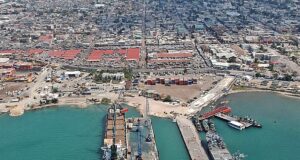11 April, 2015
By Tom Fenton
The increasing influence of Iran in Iraq is currently unchecked and will have dire consequences for the stability of the region. Not only is it dividing an already fragile country, it is also laying the groundwork for the formation of a rump state answerable to Tehran alone.
According to General Martin Dempsey, the chairman of the US Joint Chiefs of Staff, 20,000 of the 24,000 troops involved in the just complete Tikrit offensive were “Iranian trained and somewhat Iranian equipped” and were fighting under the banner of al-Hashd al-Shaabi or Popular Mobilisation Forces. The group’s current leader, Abu Mahdi al-Muhandis, is designated a “terrorist” by the Americans “for threatening the peace and stability of Iraq and the Government of Iraq” and for attacking coalition forces during the Iraq War. He is known to have worked for the Iranian regime since the 1980s, when he allegedly organised attacks on the US and French embassies in Kuwait. In contrast to the huge proportion of Iranian-backed personnel, only 3,000 American trained Iraqi troops were involved in the Tikrit operation, along with 1,000 Sunni tribesmen.
An Iraqi official has told the Associated Press that over the past year, the Iranians have sold Iraq nearly $10 billion worth of equipment, a huge amount similar in value to the entire Iranian defence budget. In comparison, the Pentagon requested only approximately $90 million worth of weapons and equipment to provide to Iraqi forces. Amongst the most notable items Iran has supplied Iraq with are an unknown number of Iranian Fajr-5 artillery rockets ‒ with a range of 75km, and Fateh-110 surface-to-surface missiles ‒ with a range of 300km. Although these weapons were not used in the battle for Tikrit, it is possible that they are being deployed in preparation for the fight for Mosul, Iraq’s second biggest city, which is currently under Islamic State occupation. The rockets ‒ brought into Baghdad from Iran via the two or three daily flights that now constitute one of Iraq’s main weapons supply lines ‒ are not precision guided, and so their use in populated areas would very likely result in high civilian casualties. The Iranians have also supplied the Iraqis with surveillance drones.
In addition to acting as an arms supplier, Iran has used its own military to attack Islamic State militants. Last November, Iranian pilots bombed towns in Diyala province, including the towns of Jalawla and Sadiya, less than twenty miles from the Iranian border. Hamid Reza Taraghi, a conservative Iranian politician close to Iran’s Supreme Leader Ali Khamenei, told the LA Times that the province was seen as “a buffer zone”.
The individual responsible for Iranian operations inside Iraq is Qassem Suleimani, commander of the Iranian Revolutionary Guards’ Quds Force (designated a terrorist organisation by the US government) ‒ the body which is responsible for Iran’s extraterritorial operations. Christopher Harmer, a former aviator in the United States Navy in the Persian Gulf and now an analyst with the Institute for the Study of War, has described him as “a more stately version of Osama bin Laden.” He directed Shi’ite militias against the US-led coalition during the Iraq War, and supplied material support through the provision of advanced IEDs capable of puncturing the armour plating that protected allied vehicles. General David Petraeus, previously the top US commander in Iraq, once described him as “a truly evil figure”. One former US general estimated that his operations were responsible for one-third of all US casualties during the conflict, or approximately 1,500 deaths. The General has been the subject of a United Nations Security Council travel ban and asset freeze since 2007. In many ways the appearance of the once-shadowy character is a propaganda tool aimed at the Americans: his presence is designed to give the impression that Iran is defending Iraq without US guidance and that it is Tehran ‒ not Baghdad or Washington ‒ that is in control of the battle against Islamic State. He was seen on front lines near Amerli in 2014 and in March this year, he was photographed drinking tea with fighters near Tikrit. In February this year, he boasted during a rally celebrating the 36th anniversary of the 1979 Revolution: “We are witnessing the export of the Islamic Revolution throughout the region. From Bahrain and Iraq to Syria, Yemen and North Africa.”
The unprecedented authority of Iran in Iraq is particularly dangerous because Iraq is built upon a sectarian tinderbox. At a hearing of the Senate Armed Services Committee on March 3, US Defence Secretary Ashton Carter said: “I do look at [sectarianism] with concern. We’re watching it very closely.” General Dempsey added that he was “very concerned” about what would happen in the country following the demise of Islamic State. It was very obvious at the hearing that the Americans are worried about the influence of Iran since the country ‘came up’ almost as many times as Iraq (67 mentions against 79). The Iranian regime does not understand the word ‘inclusive’ and it is clearly exporting sectarianism to Iraq. The United States and its allies will be in no position to fight the long-term battle for a future, stable, inclusive and united Iraq if Iran continues to milk the symptoms of such sectarianism for its own ends.
This threat of sectarianism is clear ‒ and indeed is already being manifest ‒ in many parts of the country. A damning report by Amnesty International in October 2014 found evidence of human rights abuses, including war crimes, committed by Shi’ite militias against Sunni civilians. Amnesty found “a consistent pattern of deliberate, execution-style killings” with scores of civilians still missing. Human Rights Watch found similar evidence in a report published in February 2015. Many Sunnis are understandably fearful of revenge attacks from the Shi’ite militias after thousands of Shi’a were murdered by Islamic State militants and Sunni tribesmen in their rapid advance last June, including perhaps 1,700 cadets in Tikrit last June. In January 2015, Iraqi Prime Minister Haider al-Abadi launched an investigation after accusations were made that Shi’ite militiamen had murdered 70 people in Diyala province after Islamic State militants were expelled. Although he says the army will give Tikrit, Saddam Hussein’s hometown and a Sunni stronghold, to Sunni tribes now it has been retaken, this action is difficult to envisage, since only a tiny fraction of the troops available in the area are Sunni tribesmen or Iraqi governmental forces. The Iranian-led campaign to remove Islamic State from Tikrit is also worrying because it is located in Saladin Province, a Sunni-dominated region. The Iranians are therefore not only interested in having influence over Shi’ite areas but also over Sunni-dominated lands too, all with the eventual aim of making Iraq a “de facto Shiite satellite of Tehran”.
US Secretary of State John Kerry has said that the campaign to retake Tikrit “was put together by the Iraqis, formulated by the Iraqis, executed by the Iraqis, and that’s the best thing all of us could, frankly, ask for”. That is untrue. The Iranians have formed Shi’ite militias who make up most of the fighting force against Islamic State: they are trained, funded and equipped by Tehran, and General Suleimani ‒ a designated terrorist under United Nations sanctions ‒ lead the battle from the frontlines. No support from US air power was requested until the capture of the city was almost complete, and the Americans did not approve the battle plans for Tikrit before the campaign to retake the city was launched. The more the Iranians assist and support the government, the more power they will hold in Baghdad. General Dempsey is wrong to say that Iran’s support for Iraq is “a positive thing”. In the long term, General Petraeus’ recent warning that Iran is a bigger threat to Iraq than the Islamic State is a sound argument. Iran will not look to form a unity government. Instead, it will form one which it can rule from Tehran. In contrast, it must be the role of the West to ensure a unified and inclusive government is formed. The Americans are tacitly supporting the Iranians in a myopic move that will only fuel the fires of sectarianism. Iran’s only interest is to secure its borders and form a puppet state. The American administration’s lack of action is only deepening the sectarian divide and will push Sunnis into extreme militant groups and will limit their future abilities to participate in the governing of Iraq.
Iran’s influence is spreading. It exerts control over Hezbollah in Beirut, over Bashar al-Assad in Damascus, over the Houthi rebels in Yemen, and now over the Iraqi government in Baghdad. The battle for Iraq cannot be allowed to turn into an Iranian strategic victory, as that will destroy Iraq’s chance for freedom, liberty and unity ‒ something for which the Americans, their allies and the Iraqi people have spent trillions of dollars and thousands of lives. The West’s fight for Iraq must have a realistic, long-term strategy: defeat the Islamic State and build the foundations for a real political solution in Iraq. If it does not do this, it will no longer be talking to the Iraqi government in Baghdad, but to Tehran.
 Human Security Centre Human Rights and International Security Research
Human Security Centre Human Rights and International Security Research



